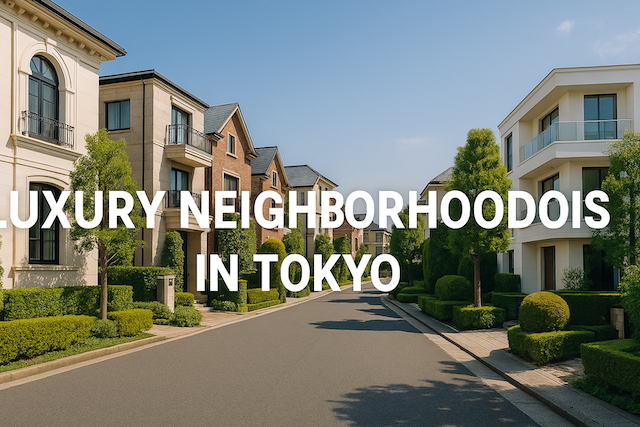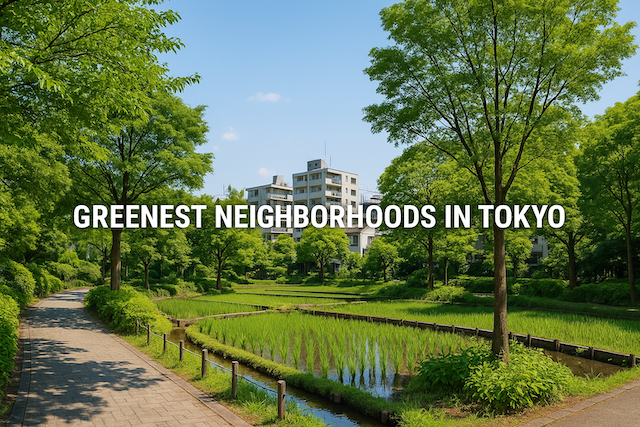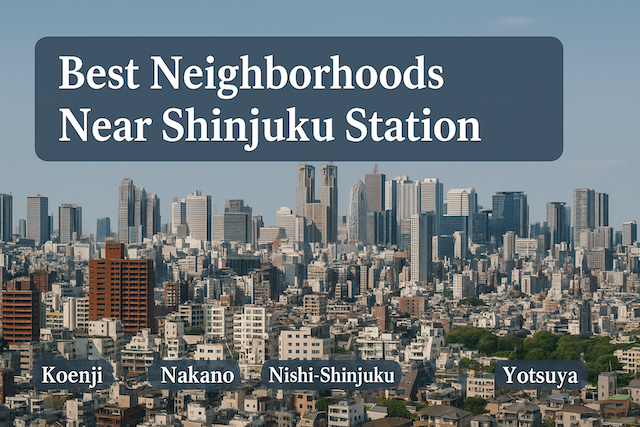Where to Live in Tokyo for Artists and Creatives
Tokyo has long been one of the most inspiring cities in the world for artists, musicians, designers, and creative thinkers. From underground galleries and experimental music venues to quiet workspaces and vibrant street art scenes, the city offers countless places where creativity thrives. However, choosing the right neighborhood can make all the difference in your artistic journey.
In this guide, we’ll explore the best areas in Tokyo for artists and creatives, covering affordability, atmosphere, community, and access to cultural hubs.
Why Tokyo Attracts Artists and Creatives
Tokyo is not just Japan’s capital—it’s a cultural magnet that constantly evolves. The city seamlessly blends tradition and modernity, making it a perfect environment for creative expression. From high-end art institutions like the Mori Art Museum to small indie galleries in converted warehouses, Tokyo’s diversity gives every artist a place to belong.
The city also hosts numerous art festivals, creative residencies, and exhibitions, such as Design Festa, Tokyo Art Book Fair, and Roppongi Art Night. Whether you’re a painter, filmmaker, sculptor, or musician, Tokyo offers endless collaboration opportunities and inspiration at every corner.
Factors to Consider When Choosing a Neighborhood
Before diving into specific areas, think about what matters most to your lifestyle and work habits:
-
Budget: Tokyo’s rent prices vary widely. Some neighborhoods are artist-friendly but still affordable.
-
Atmosphere: Do you prefer a quiet area for reflection, or a bustling district full of nightlife and events?
-
Community: Creative networks, coworking spaces, and local art scenes can help you grow.
-
Accessibility: Easy access to galleries, studios, and public transport is essential for most creatives.
1. Koenji – Tokyo’s Bohemian Heart
Koenji, located in Suginami Ward, is often called the “Bohemian center” of Tokyo. Known for its underground music scene, vintage clothing shops, and cozy izakayas, it’s one of the best places for artists, musicians, and free spirits.
Why Artists Love Koenji
-
Affordability: Compared to central Tokyo, Koenji offers relatively low rent.
-
Creative Culture: Small live houses, record stores, and art cafés dominate the streets.
-
Community: Local events like the Koenji Awa Odori festival and various street art gatherings bring together creatives from all walks of life.
If you’re into music, illustration, or alternative fashion, Koenji is a great place to find like-minded people.
2. Shimokitazawa – Indie and Vintage Paradise
Shimokitazawa, or “Shimokita,” is another beloved area for creative souls. Located near Shibuya, this neighborhood is famous for its indie theaters, secondhand stores, and laid-back lifestyle.
Highlights of Shimokitazawa
-
Theater Scene: Small theaters host independent performances and plays almost daily.
-
Music Culture: You’ll find intimate venues offering live performances from up-and-coming artists.
-
Cafés and Galleries: Perfect spots to meet other creatives or work on your art projects.
Shimokitazawa recently underwent redevelopment, adding modern shopping complexes while keeping its nostalgic charm. It’s ideal for younger artists who want a lively yet cozy place to live.
3. Nakameguro – Stylish and Sophisticated
For creatives drawn to design, photography, and contemporary art, Nakameguro is one of the trendiest spots in Tokyo. The area is known for its beautiful Meguro River, especially during cherry blossom season, and its collection of boutique stores and minimalist cafés.
Why Creatives Choose Nakameguro
-
Design Studios and Galleries: Many small design agencies and art galleries are based here.
-
Aesthetic Environment: Every corner looks curated, making it ideal for photographers and visual artists.
-
Networking Opportunities: You’ll find professionals from creative industries mingling in cafés and concept stores.
While rent here is higher than Koenji or Shimokitazawa, the environment and lifestyle justify the cost for many artists seeking inspiration and connections.
4. Kichijoji – Nature Meets Creativity
Kichijoji, located west of Tokyo, consistently ranks as one of the most desirable places to live. It’s loved by artists for its balance between urban comfort and natural beauty.
What Makes Kichijoji Ideal
-
Inokashira Park: A relaxing space perfect for sketching, painting, or simply walking to refresh your mind.
-
Artistic Spaces: Home to Ghibli Museum and several independent galleries.
-
Creative Community: Many designers, illustrators, and musicians live here due to its calm atmosphere and community events.
Kichijoji is perfect for artists who want inspiration from nature while still staying connected to Tokyo’s creative pulse.
5. Asakusa – Tradition and Old Tokyo Charm
Asakusa may be best known for Senso-ji Temple and its nostalgic streets, but it’s also a hidden gem for artists who appreciate craftsmanship and Japanese aesthetics.
Artistic Appeal of Asakusa
-
Craftsmanship: Many traditional artisans, such as kimono makers, woodblock printers, and ceramicists, have workshops here.
-
Cultural Heritage: The area preserves the Edo-era atmosphere, providing deep inspiration for painters and photographers.
-
Affordable Housing: Some parts of Asakusa still offer reasonable rent, especially for older apartments.
Living in Asakusa means immersing yourself in the cultural roots of Japan, perfect for artists exploring traditional styles or fusion works.
6. Daikanyama – Modern and Minimalist
Daikanyama, just a few minutes from Shibuya, is Tokyo’s version of a chic, international creative hub. It’s known for its clean design, upscale lifestyle, and fashionable residents.
Why Creatives Flock to Daikanyama
-
T-Site Complex: A cultural landmark combining architecture, books, and design.
-
Boutique Studios: Many creative agencies and photo studios operate here.
-
Modern Aesthetic: Ideal for designers, architects, and stylists.
Although rent is on the expensive side, Daikanyama’s convenience and creative energy attract professionals who want inspiration and networking opportunities in a refined setting.
7. Akihabara – For Digital and Tech Creatives
If your art is digital—like 3D modeling, animation, or gaming—Akihabara might be your ideal neighborhood. Known as the center of otaku culture, it’s where technology, anime, and gaming meet.
Reasons to Live in Akihabara
-
Access to Electronics and Tech Stores: Perfect for creatives working in media, digital design, or sound engineering.
-
Vibrant Subculture: Anime, cosplay, and retro gaming communities thrive here.
-
Inspiration Everywhere: The district’s colors, sounds, and energy stimulate new ideas.
While it’s not the quietest neighborhood, Akihabara provides unmatched access to digital tools and communities.
8. Ikebukuro – Affordable and Artistically Diverse
Ikebukuro has transformed from a commuter hub into a lively cultural district. It’s particularly appealing to young artists who want city access without high rent.
Why Ikebukuro Works for Creatives
-
Affordable Rent: Compared to Shinjuku or Shibuya, it’s easier to find budget-friendly apartments.
-
Art and Anime Culture: The area includes galleries, anime shops, and live performance venues.
-
Community Spaces: Creative coworking spaces like “IKEBUKURO Living Loop” promote collaboration among artists.
Ikebukuro’s diversity and convenience make it a smart starting point for artists beginning their careers in Tokyo.
9. Sumida and Koto Wards – Industrial Creativity
On the eastern side of Tokyo, Sumida and Koto have become new hubs for artisans and creative entrepreneurs. Once filled with factories, these areas now host art studios, shared workshops, and galleries.
Features of Sumida and Koto
-
Studio Conversions: Old factories are now artist studios or event spaces.
-
Local Art Movement: Initiatives like the Sumida Modern Project encourage collaboration between artists and traditional craftsmen.
-
Lower Rent: These wards are relatively affordable, especially compared to central Tokyo.
For sculptors, installation artists, or those working with physical materials, these districts offer the space and atmosphere needed to create freely.
Tips for Artists Moving to Tokyo
-
Join Art Communities: Participate in local workshops or join creative meetups in your area.
-
Use Shared Studios: Coworking and co-creating spaces are affordable and help you network.
-
Attend Exhibitions: Regularly visiting art fairs or open studios keeps you inspired.
-
Learn Some Japanese: Even basic language skills will help you connect with local artists and audiences.
-
Stay Flexible: Many artists move between neighborhoods as their projects and lifestyles evolve.
Conclusion: Finding Your Creative Home in Tokyo
Tokyo is not a single “creative district” but a mosaic of artistic microcosms. Whether you’re drawn to Koenji’s underground energy, Nakameguro’s sophistication, or Kichijoji’s natural serenity, there’s a place for every kind of artist.
Living in Tokyo means more than finding an apartment—it’s about discovering your own rhythm in a city that never stops inspiring. Wherever you settle, you’ll be part of one of the most dynamic creative communities in the world.
FAQs
What are the best Tokyo neighborhoods for artists and creatives?
Great picks include Koenji (bohemian music scene and vintage shops), Shimokitazawa (indie theaters and cafés), Nakameguro (design-forward galleries and riverside ambience), Kichijoji (park-side calm and community), Asakusa (traditional crafts), Daikanyama (modern creative agencies), Akihabara (digital and gaming culture), Ikebukuro (budget-friendly with venues), and the more spacious, industrial-chic zones of Sumida and Koto for studio conversions.
How should I choose the right area for my creative work?
Balance four factors: budget, atmosphere, community, and access. If you need constant inspiration and networking, look at Nakameguro or Daikanyama. If you value affordability and subculture, Koenji or Shimokitazawa shine. For larger, hands-on projects, consider Sumida/Koto’s warehouse-style studios. If nature resets your creativity, Kichijoji’s Inokashira Park is hard to beat.
Is Tokyo affordable for artists on a tight budget?
Relative to other major capitals, you can still find workable budgets by targeting neighborhoods just outside the core and by using share houses or older “mansions” (condo-style units). Koenji, Ikebukuro, and parts of Asakusa, Sumida, and Koto often offer lower rents than Shibuya- or Meguro-adjacent zones. Reducing commute needs and leveraging shared studios also stretches your budget.
Where can I find studios, maker spaces, or rehearsal rooms?
Look for shared studios and maker spaces clustered in Sumida and Koto (ex-factory conversions), rehearsal and live houses in Koenji and Shimokitazawa, and small galleries/design studios around Nakameguro and Daikanyama. Many spaces offer day passes, monthly memberships, or night-time blocks. Local community centers and university-affiliated labs sometimes rent rooms at fair rates, too.
What if my work is digital (3D, animation, game audio)?
Consider Akihabara for proximity to electronics, peripherals, and creative subcultures, or live in a quieter, cheaper ward and commute to Akiba when needed. Nakameguro/Daikanyama also host design agencies and creator cafés useful for networking. Stable high-speed internet is widely available; coworking hubs across the city provide booth rooms for voice or audio work.
How do I meet other creatives and collaborators?
Start with local cafés that double as galleries, open studios, live houses, and small theaters. Attend art book fairs, indie performances, and neighborhood festivals (e.g., Koenji’s events). Join bilingual meetups, Discord/LINE groups linked to venues, and university exhibitions. Consistency—visiting the same spots and saying hello—builds a network surprisingly fast.
Do I need Japanese to live and create in Tokyo?
No, but even basics help tremendously. Simple phrases ease apartment hunting, ordering supplies, and negotiating studio rules. Creative communities often include bilingual members, but signage, contracts, and venue guidelines can be Japanese-first. Consider a short language course or apps; it multiplies your opportunities for residencies, grants, and collaborations.
Any tips for apartment hunting as an artist?
Decide early: private apartment, share house, or live-work studio. Private units may require a guarantor and initial fees (deposit, key money, agency fee). Share houses reduce upfront costs and expand your network. Check noise rules, ventilation, elevator access, and load-in routes if you move canvases or equipment. Visit at different times to gauge sound and vibe.
How can I manage noise and neighbors with music or fabrication work?
Pick buildings with concrete construction, corner units, and clear house rules. For music, practice in a rented studio, rehearsal room, or sound-treated coworking booth rather than at home. For fabrication, use maker spaces with extraction and safety compliance. Always confirm quiet hours and building policies; good neighbor etiquette preserves your creative freedom.
What does daily life feel like in these creative districts?
Koenji and Shimokitazawa feel casual and walkable, with thrift stores, small venues, and late-night bites. Nakameguro and Daikanyama feel curated and design-led, with serene streets and stylish cafés. Kichijoji blends bustle with park calm. Sumida/Koto are practical and spacious, with growing arts ecosystems. Each area has a different rhythm—visit before choosing.
How do I keep costs down while staying inspired?
Use city libraries, community centers, and discounted museum days. Share subscriptions (software/hardware) within trusted circles. Split studio memberships. Buy secondhand gear in Koenji, Akihabara, or online marketplaces. Batch errands to limit transit costs. Most importantly, set up a walking loop—Tokyo’s street-level texture offers free, daily inspiration.
Is Tokyo safe for late-night rehearsals or gallery work?
Generally yes, though standard urban precautions apply. Stick to well-lit streets, keep valuables close, and plan last trains. Many creative districts remain lively into the evening. If you’ll finish late, choose housing within walking/bike distance of your studio or a station with strong night bus or taxi coverage.
What should international artists know about visas and work?
Visa categories and permitted activities matter. If you’ll sell work, perform, or freelance, ensure your status allows it and keep records for taxes. Galleries, schools, and sponsors sometimes support applications. Even if you begin on a student or other status, plan for legal pathways if your creative practice becomes income-generating.
Are there opportunities tied to traditional Japanese crafts?
Yes. Asakusa, Sumida, and other historical craft areas host workshops in printmaking, dyeing, leather, ceramics, and metal. Many craftspeople collaborate with contemporary designers. Approach respectfully: learn basics, understand shop etiquette, and ask about apprenticeships or short-term lessons. Blending traditional techniques with modern design is a thriving niche.
How can I test an area before committing to a lease?
Book a month in a share house or short-stay apartment near your target district. Work in local cafés and studios, attend a few shows, and walk your commute. Track noise, crowds, and closing times. If it supports your workflow for two or three weeks, you’ve likely found a good match.
What’s a simple decision flow for picking my neighborhood?
- Need subculture and low costs? Try Koenji or Shimokitazawa.
- Want sleek design and networking? Nakameguro or Daikanyama.
- Crave nature resets? Kichijoji.
- Digital-first practice? Live anywhere calm, commute to Akihabara.
- Large-format or fabrication? Sumida or Koto studios.
- Starter budget + access? Ikebukuro and nearby wards.
https://tokyorelocationguide.com/neighborhoods/




![Where to Live in Tokyo for Couples [2025-2026 Guide]](https://tokyorelocationguide.com/wp-content/uploads/2025/10/ChatGPT-Image-Oct-17-2025-04_22_42-PM.png)


